Satellite Soil Moisture Validation Using Hydrological SWAT Model: A Case Study of Puerto Rico, USA
Abstract
:1. Introduction
2. Materials and Methods
2.1. Study Area
2.2. Data Sources
2.3. Model Application
2.4. Streamflow Generation
2.5. Bias Correction
2.6. Model Run
3. Results and Discussion
3.1. Model Sensitivity Analysis
3.2. Calibration and Validation
3.3. Streamflow Assessment
4. Conclusions
Acknowledgments
Author Contributions
Conflicts of Interest
References
- Walker, J.P.; Dumedah, G.; Monerris, A.; Gao, Y.; Rüdiger, C.; Wu, X.; Panciera, R.; Merlin, O.; Pipunic, R.; Ryu, D.; et al. High resolution soil moisture mapping. In Computing Ethics: A Multicultural Approach; Chapman & Hall/CRC: London, UK, 2016; p. 45. [Google Scholar]
- Dorigo, W.A.; Wagner, W.; Hohensinn, R.; Hahn, S.; Paulik, C.; Xaver, A.; Gruber, A.; Drusch, M.; Mecklenburg, S.; van Oevelen, P.; et al. The International Soil Moisture Network: A data hosting facility for global in situ soil moisture measurements. Hydrol. Earth Syst. Sci. 2011, 15, 1675–1698. [Google Scholar] [CrossRef]
- Laiolo, P.; Gabellani, S.; Pulvirenti, L.; Boni, G.; Rudari, R.; Delogu, F.; Silvestro, F.; Campo, L.; Fascetti, F.; Pierdicca, N.; et al. Validation of remote sensing soil moisture products with a distributed continuous hydrological model. In Proceedings of the 2014 IEEE International Geoscience and Remote Sensing Symposium (IGARSS), Quebec City, QC, Canada, 13–18 July 2014; pp. 3319–3322. [Google Scholar]
- Merlin, O.; Walker, J.; Panciera, R.; Young, R.; Kalma, J.; Kim, E. Soil moisture measurement in heterogeneous terrain. In Proceedings of the Congress Theme of Land, Water and Environmental Management: Integrated Systems for Sustainability, Christchurch, New Zealand, 10–13 December 2007; pp. 2604–2610. [Google Scholar]
- Wanders, N.; Karssenberg, D.; De Roo, A.; De Jong, S.M.; Bierkens, M.F.P. The suitability of remotely sensed soil moisture for improving operational flood forecasting. Hydrol. Earth Syst. Sci. 2014, 18, 2343–2357. [Google Scholar] [CrossRef]
- Kumar, S.V.; Peters-Lidard, C.D.; Santanello, J.A.; Reichle, R.H.; Draper, C.S.; Koster, R.D.; Nearing, G.; Jasinski, M.F. Evaluating the utility of satellite soil moisture retrievals over irrigated areas and the ability of land data assimilation methods to correct for unmodeled processes. Hydrol. Earth Syst. Sci. 2015, 19, 4463–4478. [Google Scholar]
- Liu, L. Soil Moisture Mapping in Vegetated Area Using Landsat and Envisat ASAR Data. In Proceedings of the 1st International Electronic Conference on Remote Sensing, Dresden, Germany, 22 June–5 July 2015; pp. 1–7. [Google Scholar]
- Martínez-Fernández, J.; González-Zamora, A.; Sánchez, N.; Gumuzzio, A.; Herrero-Jiménez, C.M. Satellite soil moisture for agricultural drought monitoring: Assessment of the SMOS derived Soil Water Deficit Index. Remote Sens. Environ. 2016, 177, 277–286. [Google Scholar] [CrossRef]
- Entekhabi, D.; Njoku, E.G.; O’Neill, P.E.; Kellogg, K.H.; Crow, W.T.; Edelstein, W.N.; Entin, J.K.; Goodman, S.D.; Jackson, T.J.; Johnson, J.; et al. The soil moisture active passive (SMAP) mission. Proc. IEEE 2010, 98, 704–716. [Google Scholar] [CrossRef]
- Kolassa, J.; Gentine, P.; Prigent, C.; Aires, F.; Alemohammad, S.H. Soil moisture retrieval from AMSR-E and ASCAT microwave observation synergy. Part 2: Product evaluation. Remote Sens. Environ. 2017, 195, 202–217. [Google Scholar] [CrossRef]
- Ban, Y.; Marullo, S.; Eklundh, L. European Remote Sensing: Progress, challenges, and opportunities. Int. J. Remote Sens. 2017, 38, 1759–1764. [Google Scholar] [CrossRef]
- Zhuo, L.; Han, D. Hydrological Evaluation of Satellite Soil Moisture Data in Two Basins of Different Climate and Vegetation Density Conditions. Adv. Meteorol. 2017, 2017, 1086456. [Google Scholar] [CrossRef]
- Gruhier, C.; de Rosnay, P.; Hasenauer, S.; Holmes, T.; de Jeu, R.; Kerr, Y.; Mougin, E.; Njoku, E.; Timouk, F.; Wagner, W.; et al. Soil moisture active and passive microwave products: Intercomparison and evaluation over a Sahelian site. Hydrol. Earth Syst. Sci. 2010, 14, 141–156. [Google Scholar] [CrossRef] [Green Version]
- Xiao, Z.; Jiang, L.; Zhu, Z.; Wang, J.; Du, J. Spatially and temporally complete satellite soil moisture data based on a data assimilation method. Remote Sens. 2016, 8, 49. [Google Scholar] [CrossRef]
- Wu, Q.; Liu, H.; Wang, L.; Deng, C. Evaluation of AMSR2 soil moisture products over the contiguous United States using in situ data from the International Soil Moisture Network. Int. J. Appl. Earth Obs. Geoinf. 2016, 45, 187–199. [Google Scholar] [CrossRef]
- Zhang, X.; Zhang, T.; Zhou, P.; Shao, Y.; Gao, S. Validation Analysis of SMAP and AMSR2 Soil Moisture Products over the United States Using Ground-Based Measurements. Remote Sens. 2017, 9, 104. [Google Scholar] [CrossRef]
- Brocca, L.; Ciabatta, L.; Massari, C.; Camici, S.; Tarpanelli, A. Soil Moisture for Hydrological Applications: Open Questions and New Opportunities. Water 2017, 9, 140. [Google Scholar] [CrossRef]
- Zhuo, L.; Han, D. The Relevance of Soil Moisture by Remote Sensing and Hydrological Modelling. Procedia Eng. 2016, 154, 1368–1375. [Google Scholar] [CrossRef]
- Arnold, J.G.; Shrinivasan, R.; Muttiah, R.S.; Williams, J.R. Large area hdyrologic modeling and assessment part I: Model devlopment. J. Am. Water Resour. Assoc. 1998, 34, 73–89. [Google Scholar] [CrossRef]
- Olivera, F.; Valenzuela, M.; Srinivasan, R.; Choi, J.; Cho, H.; Koka, S.; Agrawal, A. ARCGIS-SWAT: A geodata model and GIS interface for SWAT1. JAWRA J. Am. Water Resour. Assoc. 2006, 42, 295–309. [Google Scholar] [CrossRef]
- Setegn, S.G.; Srinivasan, R.; Dargahi, B. Hydrological modelling in the Lake Tana Basin, Ethiopia using SWAT model. Open Hydrol. J. 2008, 2, 49–62. [Google Scholar] [CrossRef]
- Yacoub, C.; Foguet, A.P. Slope effects on SWAT modeling in a mountainous basin. J. Hydrol. Eng. 2012, 18, 1663–1673. [Google Scholar] [CrossRef]
- Gupta, P.K.; Punalekar, S.; Panigrahy, S.; Sonakia, A.; Parihar, J.S. Runoff modeling in an agro-forested watershed using remote sensing and GIS. J. Hydrol. Eng. 2011, 17, 1255–1267. [Google Scholar] [CrossRef]
- Williams, J.R.; Kannan, N.; Wang, X.; Santhi, C.; Arnold, J.G. Evolution of the SCS runoff curve number method and its application to continuous runoff simulation. J. Hydrol. Eng. 2011, 17, 1221–1229. [Google Scholar] [CrossRef]
- Santhi, C.; Srinivasan, R.; Arnold, J.G.; Williams, J.R. A modeling approach to evaluate the impacts of water quality management plans implemented in a watershed in Texas. Environ. Model. Softw. 2006, 21, 1141–1157. [Google Scholar] [CrossRef]
- Rajib, M.A.; Merwade, V.; Yu, Z. Multi-objective calibration of a hydrologic model using spatially distributed remotely sensed/in situ soil moisture. J. Hydrol. 2016, 536, 192–207. [Google Scholar] [CrossRef]
- Van Arkel, Z.; Kaleita, A.L. Identifying sampling locations for field-scale soil moisture estimation using K-means clustering. Water Resour. Res. 2014, 50, 7050–7057. [Google Scholar] [CrossRef]
- Srinivasan, R.; Zhang, X.; Arnold, J. SWAT ungaged: Hydrological budget and crop yield predictions in the Upper Mississipp River basin. Trans. Am. Soc. Agric. Biol. Eng. 2010, 53, 1533–1546. [Google Scholar] [CrossRef]
- Abbaspour, K.C.; Vejdani, M.; Haghighat, S.; Yang, J. SWAT-CUP calibration and uncertainty programs for SWAT. In Proceedings of the MODSIM 2007 International Congress on Modelling and Simulation, Christchurch, New Zealand, December 2007; Modelling and Simulation Society of Australia and New Zealand Inc. (MSSANZ): Christchurch, New Zealand, 2007; pp. 1596–1602. [Google Scholar]
- Arnold, J.G.; Moriasi, D.N.; Gassman, P.W.; Abbaspour, K.C.; White, M.J.; Srinivasan, R.; Santhi, C.; Harmel, R.D.; Van Griensven, A.; Van Liew, M.W.; et al. SWAT: Model use, calibration, and validation. Trans. ASABE 2012, 55, 1491–1508. [Google Scholar] [CrossRef]
- Baker, T.J.; Miller, S.N. Using the Soil and Water Assessment Tool (SWAT) to assess land use impact on water resources in an East African watershed. J. Hydrol. 2013, 486, 100–111. [Google Scholar] [CrossRef]
- Xue, C.; Chen, B.; Wu, H. Parameter uncertainty analysis of surface flow and sediment yield in the Huolin Basin, China. J. Hydrol. Eng. 2013, 19, 1224–1236. [Google Scholar] [CrossRef]
- Jha, M.K. Evaluating hydrologic response of an agricultural watershed for watershed analysis. Water 2011, 3, 604–617. [Google Scholar] [CrossRef]
- Rafiei Emam, A.; Kappas, M.; Linh, N.H.K.; Renchin, T. Hydrological Modeling and Runoff Mitigation in an Ungauged Basin of Central Vietnam Using SWAT Model. Hydrology 2017, 4, 16. [Google Scholar] [CrossRef]
- Schuol, J.; Abbaspour, K.C. Calibration and uncertainty issues of a hydrological model (SWAT) applied to West Africa. Adv. Geosci. 2006, 9, 137–143. [Google Scholar] [CrossRef]
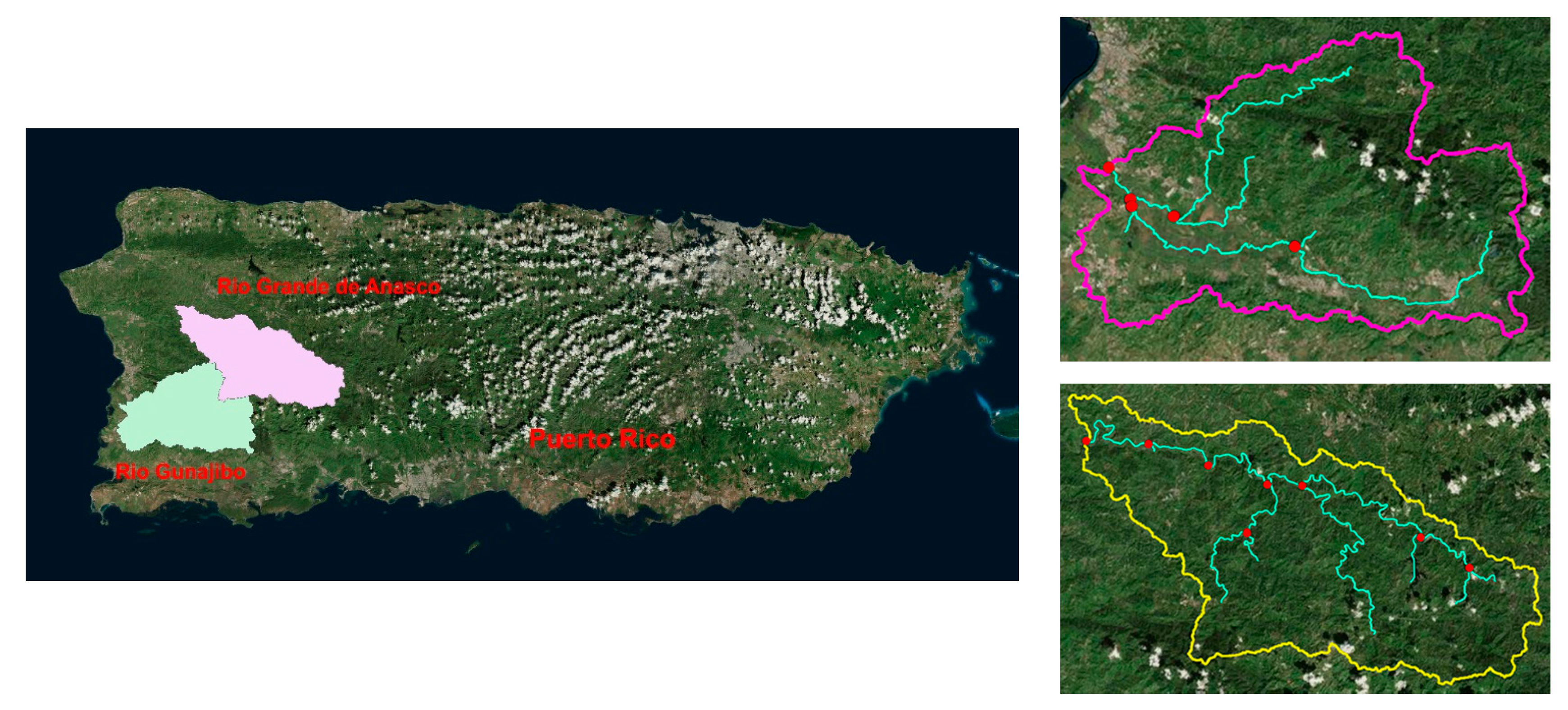
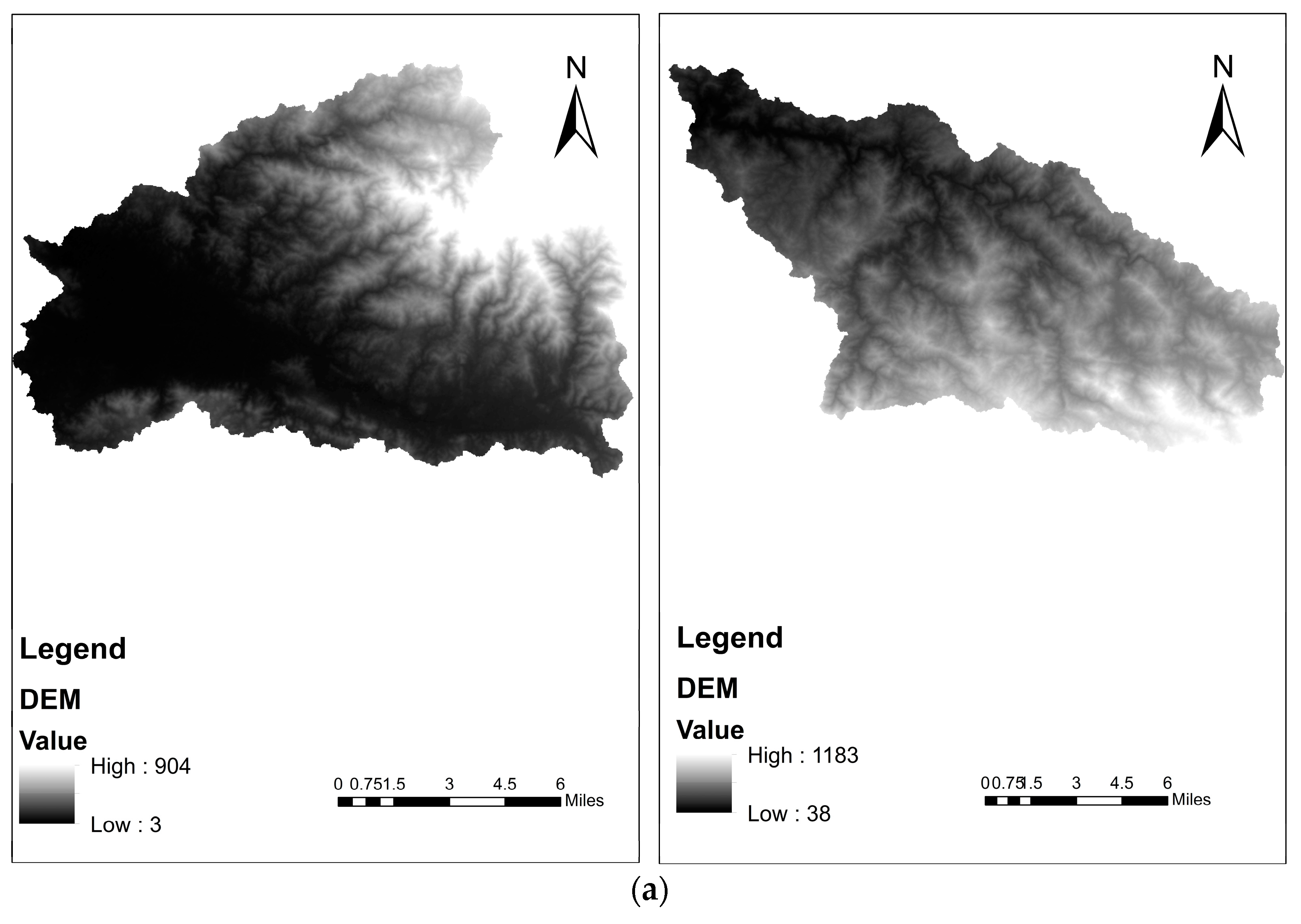
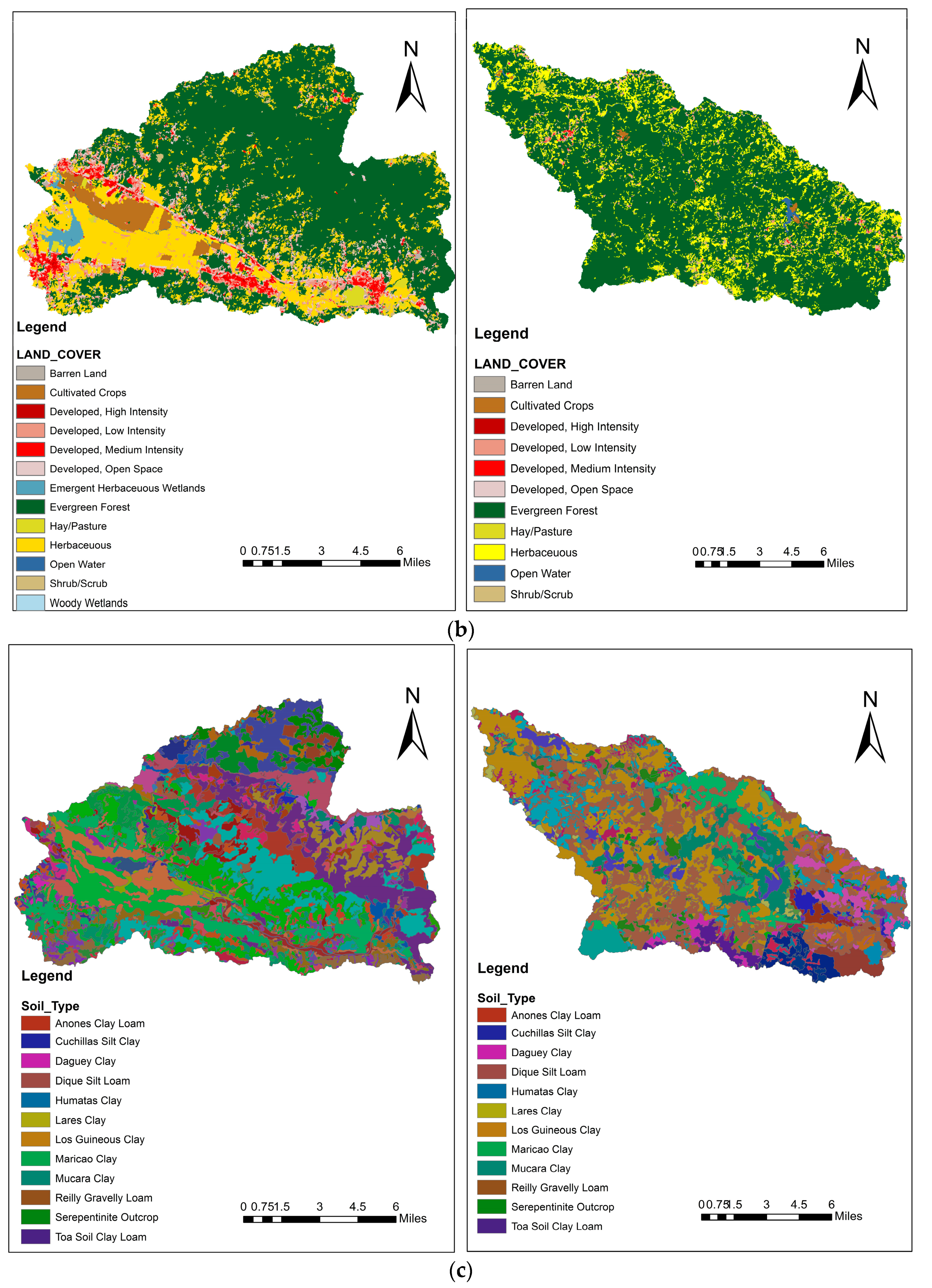

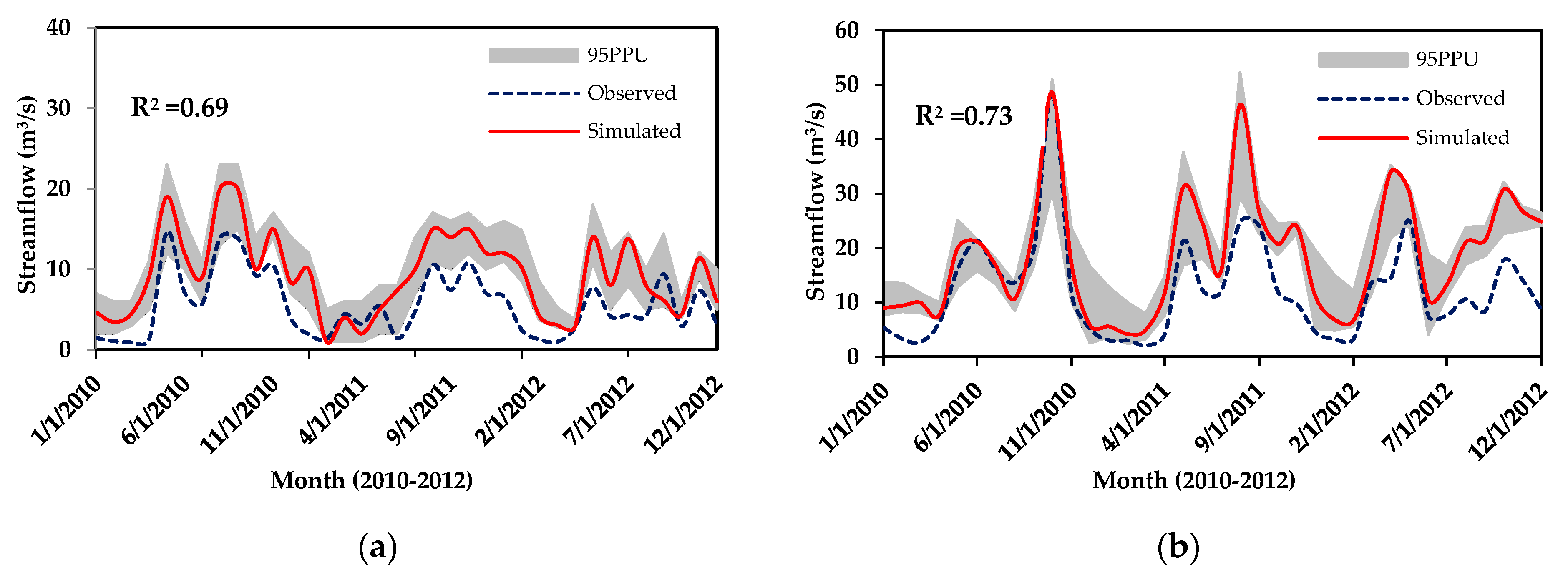
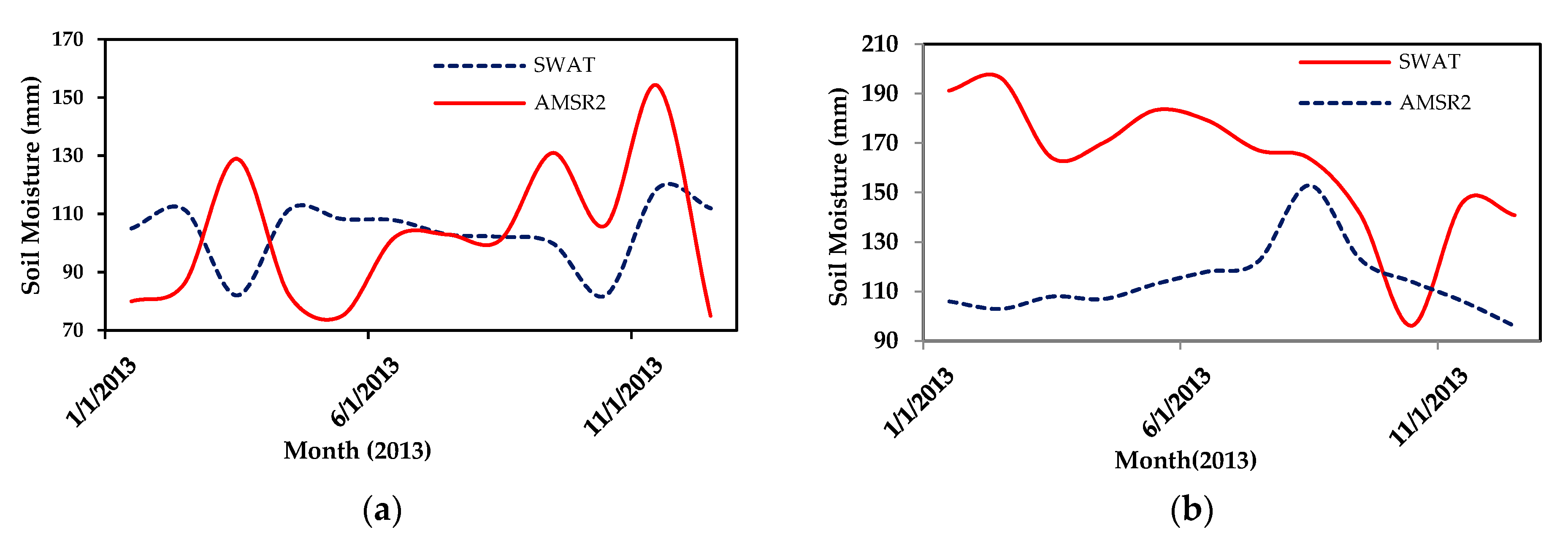
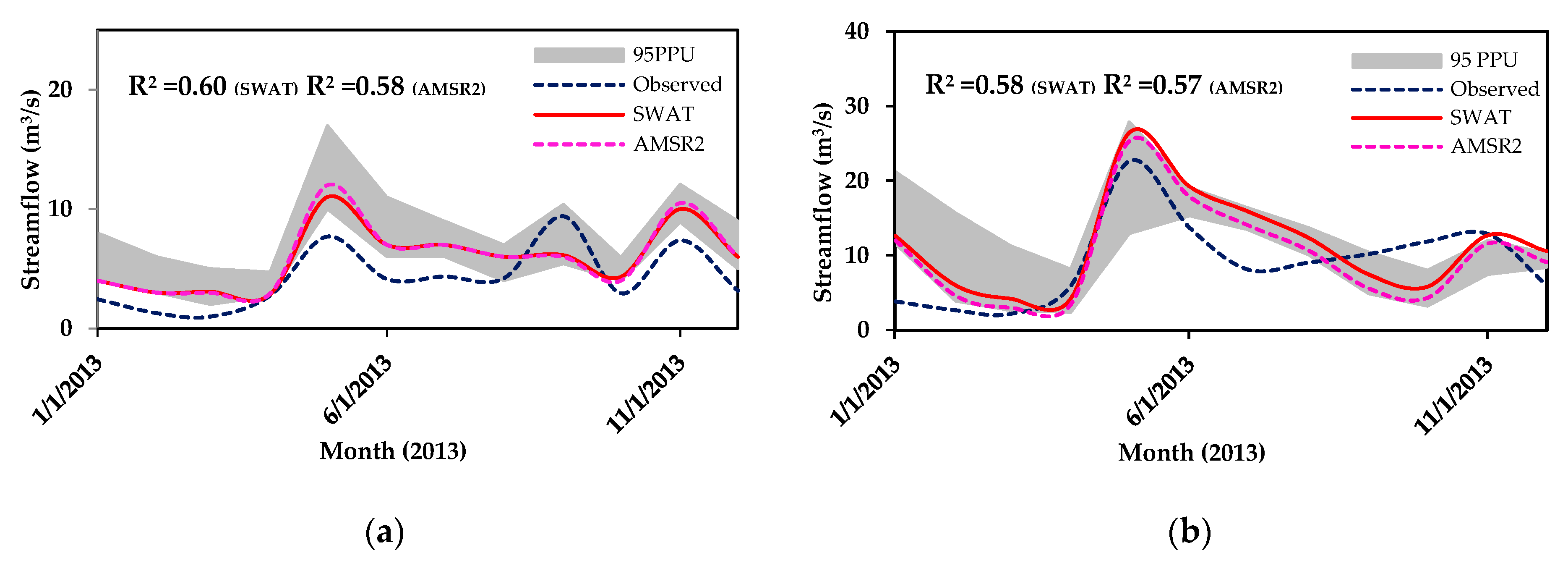
| Parameter * | Parameter Name | Initial Range | Final Range for Guanajibo | Fitted Values for Guanajibo | Final Range for Añasco | Fitted Values for Añasco |
|---|---|---|---|---|---|---|
| r_CN2 | SCS runoff curve number | −0.2 to 0.2 | −0.36 to −0.45 | −0.40 | −0.28 to −0.17 | −0.24 |
| v_ALPHA_BF | Base flow alpha factor (days) | 0 to 1 | 0 .57 to 1 | 0.72 | 0.69 to 1 | 0.7 |
| a_GW_DELAY | Groundwater delay time (days) | 30 to 450 | 31 to 256 | 198 | 20 to 58 | 38 |
| a_GWQMN | Threshold depth of water in shallow aquifer for return flow to occur (mm) | 0 to 2 | 1.3 to 2 | 1.7 | 1.43 to 2 | 1.9 |
| v_GW_REVAP | Groundwater revap. coefficient | 0 to 0.3 | 0.19 to 0.3 | 0.24 | 0.16 to 0.25 | 0.2 |
| v_ESCO | Soil evaporation compensation factor | 0.5 to 1 | 0.75 to 1 | 0.74 | 0.74 to 0.86 | 0.76 |
| v_CH_N2 | Manning’s n value for main channel | 0 to 0.3 | 0.10 to 0.27 | 0.2 | 0.20 to 0.29 | 0.25 |
| v_CH_K2 | Effective hydraulic conductivity in the main channel (mm/h) | 5 to 130 | 52 to 85 | 61 | 79 to 130 | 94 |
| v_ALPHA_BNK | Base flow alpha factor for bank storage (days) | 0 to 1 | 0.01 to 0.22 | 0.1 | 0.01 to 0.17 | 0.06 |
| r_SOL_AWC | Soil available water storage capacity (mm H2O/mm soil) | −0.2 to 0.4 | 0.05 to 0.36 | 0.35 | 0.13 to 0.32 | 0.24 |
| r_SOL_K | Soil conductivity (mm/h) | −0.8 to 0.8 | 0.14 to 0.71 | 0.6 | 0.37 to 0.79 | 0.6 |
| r_SOL_BD | Moist bulk density of first soil layer (Mg/m3) | −0.5 to 0.6 | 0.26 to 0.6 | 0.41 | 0.1 to 0.49 | 0.16 |
| v_SFTMP | Snow fall temperature(°C) | −5 to 5 | −4.34 to 1.73 | −1.3 | 1.44 to 4.67 | 1.8 |
| Rio Guanajibo | Rio Grande de Añasco | ||||
|---|---|---|---|---|---|
| Parameter | Rank | p Value | Parameter | Rank | p Value |
| ALPHA_BNK | 1 | 0.00 | ALPHA_BNK | 1 | 0.00 |
| CN2 | 2 | 0.00 | GW_DELAY | 2 | 0.00 |
| ALPHA_BF | 3 | 0.02 | CN2 | 3 | 0.03 |
| GW_DELAY | 4 | 0.02 | SFTMP | 4 | 0.03 |
| GW_REVAP | 5 | 0.05 | GW_REVAP | 5 | 0.04 |
| CH_K2 | 6 | 0.15 | SOL_AWC | 6 | 0.26 |
| SOL_BD | 7 | 0.27 | SOL_K | 7 | 0.40 |
| SOL_AWC | 8 | 0.34 | ALPHA_BF | 8 | 0.50 |
| SOL_K | 9 | 0.38 | GWQMN | 9 | 0.54 |
| ESCO | 10 | 0.47 | ESCO | 10 | 0.61 |
| GWQMN | 11 | 0.56 | CH_K2 | 11 | 0.70 |
| SFTMP | 12 | 0.64 | CH_N2 | 12 | 0.77 |
| CH_N2 | 13 | 0.75 | SOL_BD | 13 | 0.85 |
© 2017 by the authors. Licensee MDPI, Basel, Switzerland. This article is an open access article distributed under the terms and conditions of the Creative Commons Attribution (CC BY) license (http://creativecommons.org/licenses/by/4.0/).
Share and Cite
Nilawar, A.P.; Calderella, C.P.; Lakhankar, T.Y.; Waikar, M.L.; Munoz, J. Satellite Soil Moisture Validation Using Hydrological SWAT Model: A Case Study of Puerto Rico, USA. Hydrology 2017, 4, 45. https://doi.org/10.3390/hydrology4040045
Nilawar AP, Calderella CP, Lakhankar TY, Waikar ML, Munoz J. Satellite Soil Moisture Validation Using Hydrological SWAT Model: A Case Study of Puerto Rico, USA. Hydrology. 2017; 4(4):45. https://doi.org/10.3390/hydrology4040045
Chicago/Turabian StyleNilawar, Aditya P., Cassandra P. Calderella, Tarendra Y. Lakhankar, Milind L. Waikar, and Jonathan Munoz. 2017. "Satellite Soil Moisture Validation Using Hydrological SWAT Model: A Case Study of Puerto Rico, USA" Hydrology 4, no. 4: 45. https://doi.org/10.3390/hydrology4040045
APA StyleNilawar, A. P., Calderella, C. P., Lakhankar, T. Y., Waikar, M. L., & Munoz, J. (2017). Satellite Soil Moisture Validation Using Hydrological SWAT Model: A Case Study of Puerto Rico, USA. Hydrology, 4(4), 45. https://doi.org/10.3390/hydrology4040045





